First-Choice Trends Of First-Time Voters
First-time voters from every decade were asked who they would vote for in 2024.

India's political landscape is defined and redefined by the choices made by its voters. The 2024 general elections will see over 18 million first-time voters exercise their choice on who they believe is best suited to enable their aspirations and the nation’s future.
History—and conventional wisdom—tells us first-time voters have a significant sway over election outcomes. So how have first-time voters voted across generations? This question triggered a conversation with Yashwant Deshmukh, founder-director at C-Voter and culminated in a study of first-time voters. The C-Voter team connected with voters and elicited responses on key questions around the choices of voters. The research presents a decadal picture and stretches from the first general elections of 1952 to the 2024 elections.
The answers to the principal questions reveal the evolution of voting trends, who did they vote the first time and who are they voting for this time, the causal factors of the choices, the influences which determine their choices and how they feel about life in general. The micro details of the study illustrate the macro shifts in allegiances and the changing picture of India's political landscape.
Which Party Did They Vote For In First Election?
The response of first-time voters outlines the steady decline of the Indian National Congress and the rise of the Bharatiya Janata Party across decades. A good way to look at the data is to splice it into political eras.
In the period between 1950 and 1960, which is effectively the Nehruvian era, 48% and 47% of the first-time voters chose the Congress. The choice mirrors the larger-than-life image of Jawaharlal Nehru. In the 1970s, the preference for the Congress slipped dramatically to 28.7%. It is useful to recall that the slide comes in the decade when public fervour for Indira peaked following the creation of Bangladesh.
The defining factor was life and livelihoods. The 1970s was the Indira era of left-leaning economic policies, when the nation faced scarcities, when inflation was high, unemployment was spiralling and the economy was sliding down a slippery slope. Above all, the trend reflects the lethal impact of the imposition of Emergency in June 1975 and underlines the importance the young voter placed on basic freedoms.
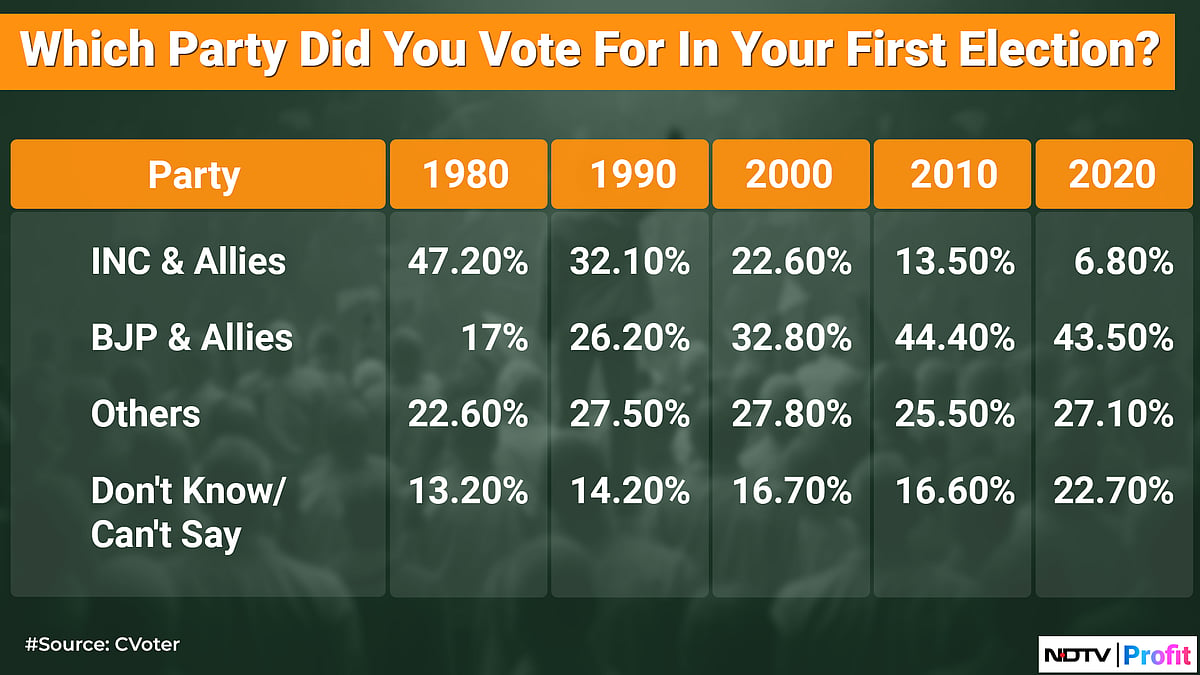
In the 1980s, the preference of first-time voters shifted back to the Congress with 47% of first-time voters choosing to vote for the party. For sure, there was anger against the strife-ridden risotto politics witnessed during the reign of the Janata Party. But the bigger factor was the quest to preserve national unity. The 1980s saw the rise of secessionist forces in Punjab and Kashmir and the assassination of Indira Gandhi. The glimmer of hope presented by Rajiv Gandhi's vision of a tech-enabled India sustained the trend before it was shelled by the Bofors scandal.
The share of first-time voters choosing the Congress slid to 32% in the 1990s but the party managed to retain an edge over others. The thin edge over other parties is explained by two black swan events—the assassination of Rajiv Gandhi in 1991 and the support for the opening up of the economy, aka dismantling of licence raj and liberalisation unleashed by PV Narasimha Rao. Thereafter, the data reveals a secular decline in the preference for Congress and a marked shift towards the BJP, spurred by the Ram temple movement and the arrival of Hindutva.
The shift of affiliation of first-time voters for the BJP is a striking reflection of its evolution as the principal opposition in the 1990s to its emergence as the first choice for governance. Between 1990 and 2000—even when the United Progressive Alliance was in power—the choice of the BJP as the preferred party among first-time voters rose from 26.2% to 32.8%. The arrival of the Modi era saw a near vertical rise—driven again by multiple abstractions, grievances and hopes—propelling the BJP as the first choice for over 44% of the first-time voters.
Who Would They Vote For In 2024?
First-time voters from every decade were asked who they would vote for in 2024. The responses represent a stark shift in preferences. The popular perception is that those younger vote for the BJP but the response to this question shows that the tilt is across demographic segments. Every second voter—polled across the universe of first-time voters from 1950s to the 2020s—indicate a preference for the BJP.
Splice the data for age groups or by political eras and the response is telling. Over 54% of those who voted the first time in the Nehru era, 64% of those who voted the first time in the Indira era, 50% of those who made their debut in the Rajiv era, 55% of those who voted the first time in the Vajpayee era and 45% of those who voted first in the UPA era signal a preference for the BJP. And 56% of those who voted for the first time in the reign of the Modi 'sarkar' have chosen the BJP.
The trajectory highlights the force of events in the choice of preferences. The debacle against China in the 1962 followed by the civil strife in the 1970s and the imposition of Emergency catalysed two generations of voters to shift allegiance to the BJP and create the base for anti-Congressism. The political landscape afforded the two generations options and they voted with their feet. The so-called "WhatsApp uncle" is effectively the angry young man of the 1960s and 1970s. The expansion of this base was enabled by flailing governance, rise of family-run political enterprises and corruption.
The choice is no doubt influenced by the force of personality, but it is also scaffolded by support for issues and driven by aspirations.
What's The Basis For Choosing The Party Or Alliance?
Generally, the choice of a party is triggered by causes, ideology or issues. What is remarkable is that while ideology or a particular issue is important, it is the role of personality which drives the choice of first-time voters. First-time voters—in every decade—cite support or opposition to a certain leader as the principal reason for choosing a particular party over the others. In the current decade, over 15.5% of the first-time voters decide voting preference on the basis of leadership followed by "issues" and "ideology".
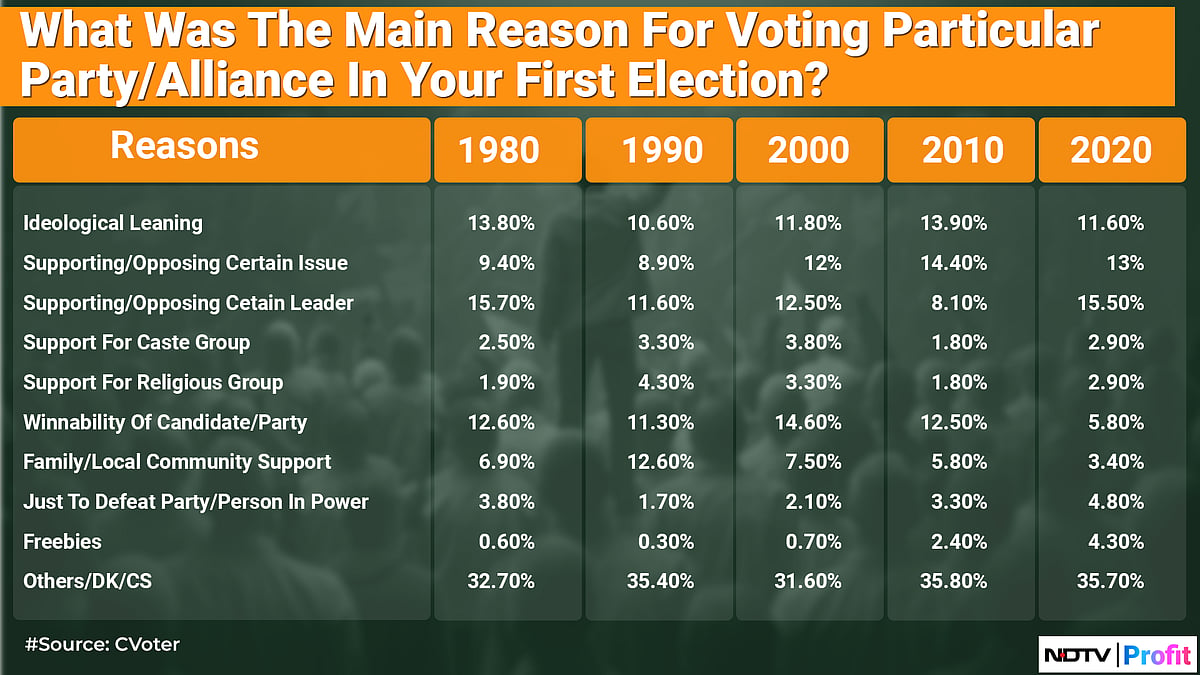
In every election, parties engage with voters to emphasise and underline the performance of their government (and the opposition its failings) to persuade voters to choose their party symbol at the polling booth. It is instructive to note that (barring the period between 1970 and 1990) choice is propelled by perception about the leader and leadership. Indeed, the trend has only accentuated in the past two decades.
The C-Voter study shows that in the Lok Sabha polls in the new millennium, the choice of the party is determined not so much by the quality of the representation of MPs or the performance of the government but is riveted on the performance of the prime minister. Over 30% of the first-time voters in the past three decades arrived at their choice of which party to vote, essentially on their assessment of the performance of the prime minister. In a sense, it mirrors the fact that over the years, elections in India’s parliamentary system are increasingly presidential in nature.
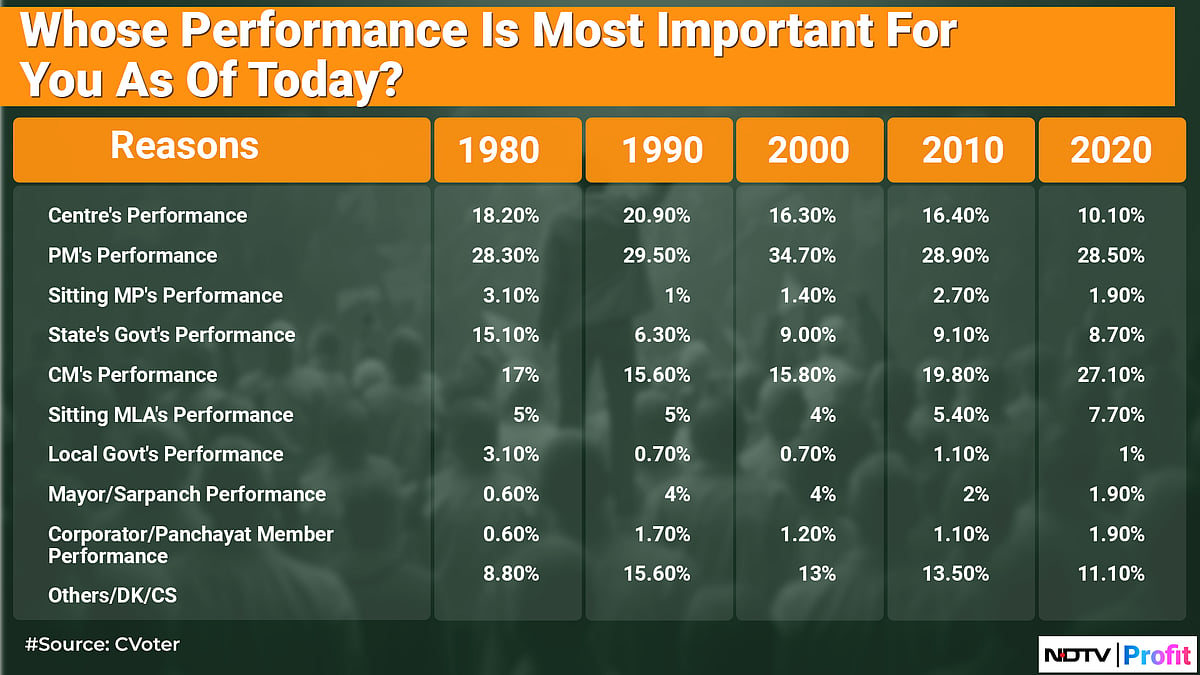
How Have Issues, Priorities Panned Over Years?
Every generation of first-time voters believes that the issues and priorities, the prism of concerns defining political preference is changing. Over two-thirds of those who voted the first time between 1950s and 1980s state the prism of concerns defining political preference has changed. What is interesting is that even the newer new voters believe that issues and priorities have changed. This could be a signal about the rise of emotive issues or a shift in aspirations.
What is the most important issue in 2024? There is change and then, there is the constant. Unemployment, the quest for livelihood, tops the list of concerns across generations of first-time voters. The broad consensus on primacy of the issue is striking. It ranges from those who voted the first time in the 1950s and are ostensibly grandparents to those who voted the first time in the eighties and are parents and of course the youth who voted the first time in this century and belong to the young adult working-age populace.
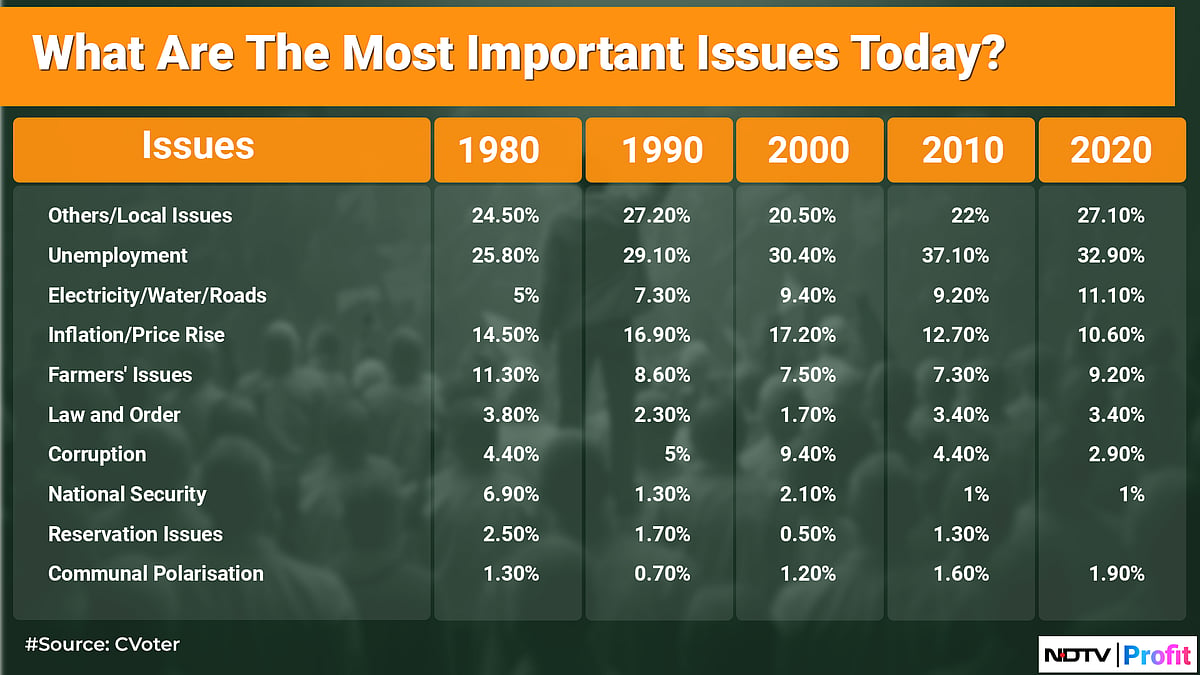
What's The Driving Influence In Choice Of Who To Vote For?
Is it parents, siblings, friends, relatives, mentors, spouse, colleagues, neighbours or friends who have an influence on the choice of the party to vote? Data from the study shows that parents have had a significant influence in the past—in the 1950s and 1990s—but first-time voters have largely come to the decision on which party to vote on their own.
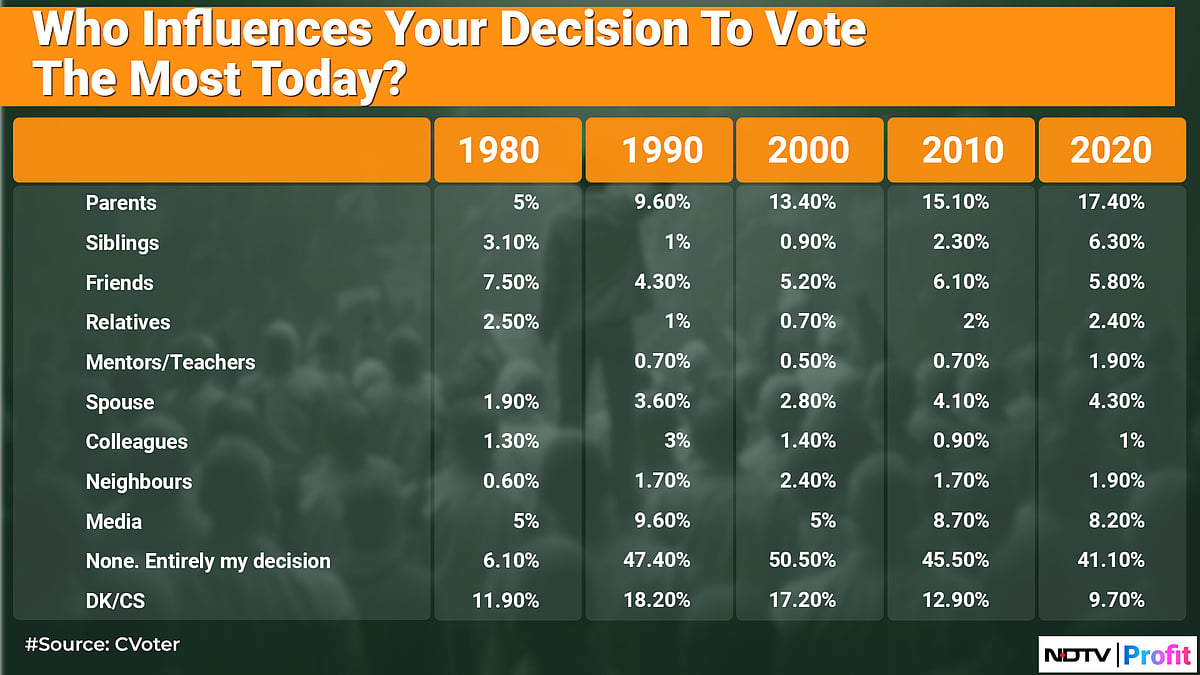
A curious aspect revealed by the responses is that while the decision or choice of party to vote is characterised as their own call, there is an uncanny alignment within the family, whether the person voted the first time in the 1950s or in 2020s. Over two-thirds of the respondents across generations of first-time voters reveal that "everyone in the family votes for the same party/candidate". The question that begs an answer is to what extent the young mind influencing electoral outcomes is being influenced by family traditions.
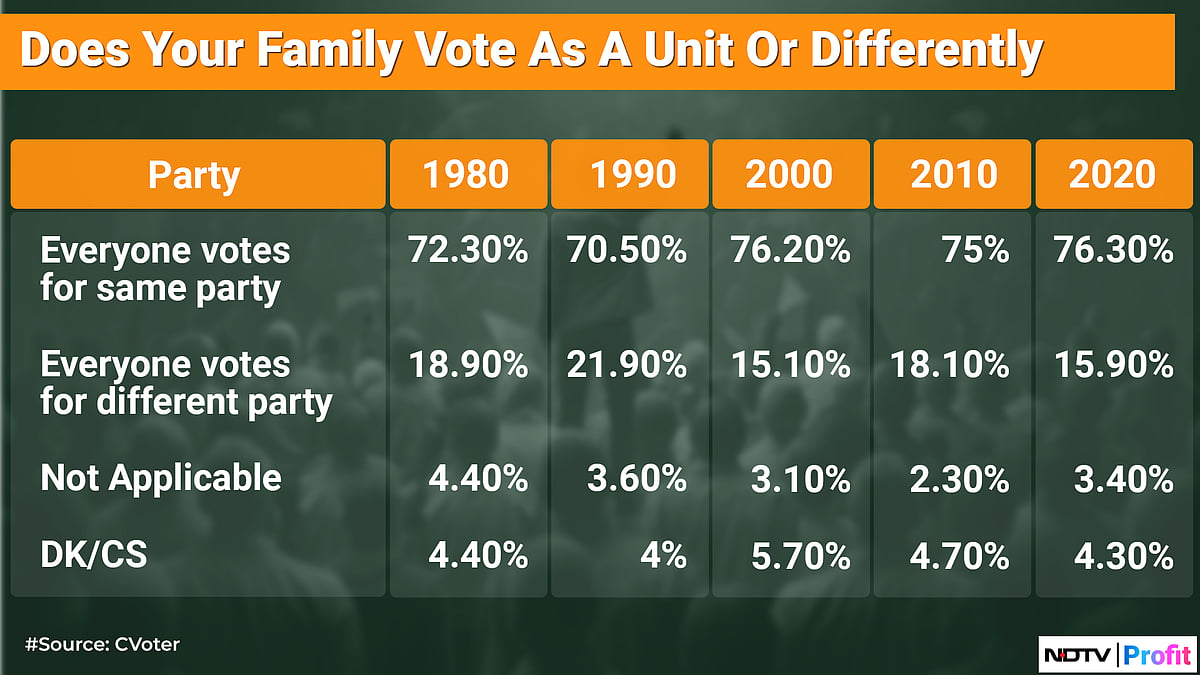
What Is The Source Of Information For The Decision?
The response of first-time voters is also an eloquent testimony on the evolution of media over the decades. Between the 1950s and the 1990s, radio ruled the roost in influencing views and choices of first-time voters.
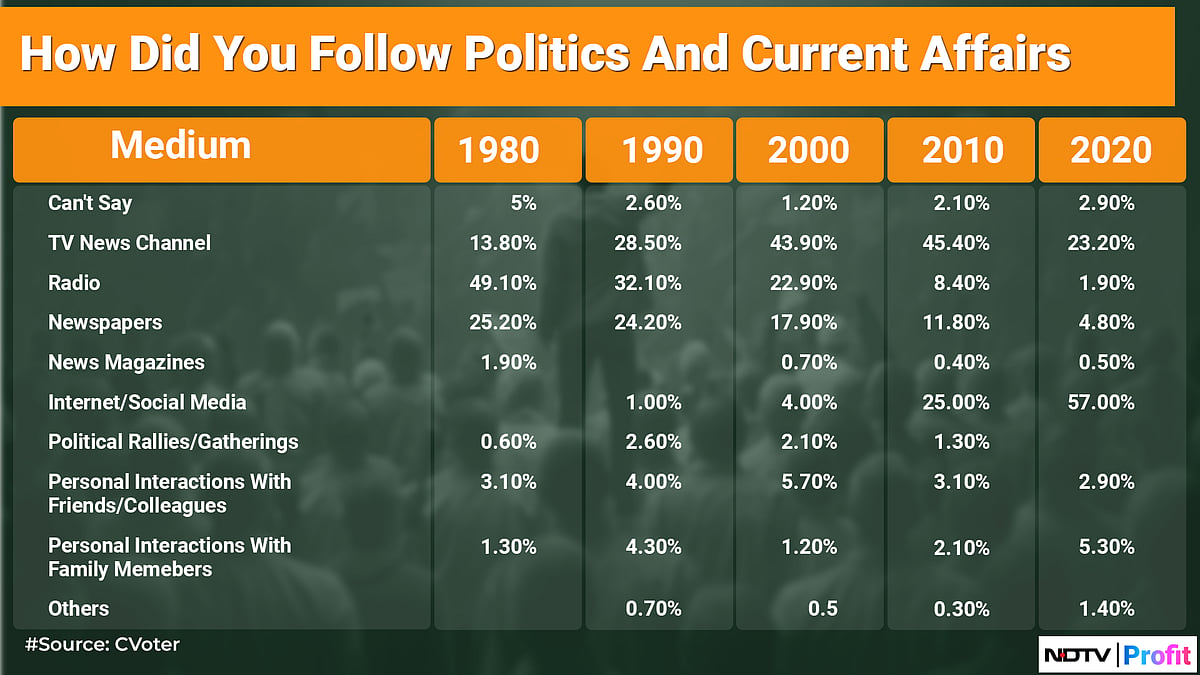
In the new millennium following the advent of private news channels, it was television which held a sway over voters and their views. In the past decade internet, aka online news and social media—think Facebook, Twitter and Instagram—are the go-to destinations for voters. In this decade, over 57% of the first-time voters make up their mind based on their engagement on internet and social media.
So, we know what influenced the minds of first-time voters when they voted the first time. What is the medium which influences them today? The responses reveal an interesting slice of the demographic distribution across media platforms. For instance, those who depended on the radio—between the 1950s and the 1990s—have switched to the visual medium and now choose to seek their information from television channels. The others—those who voted first in the past three decades—access their news/information/views from online sources and social media sites.
The exploration of preferences of first-time voters and the evolution of shifting allegiances offers an eloquent chronicle on the interplay of ideas and identities across decades. It is a testament to the persistence of faith in the power of participation for change and illuminates the live miracle in the world's largest democracy.
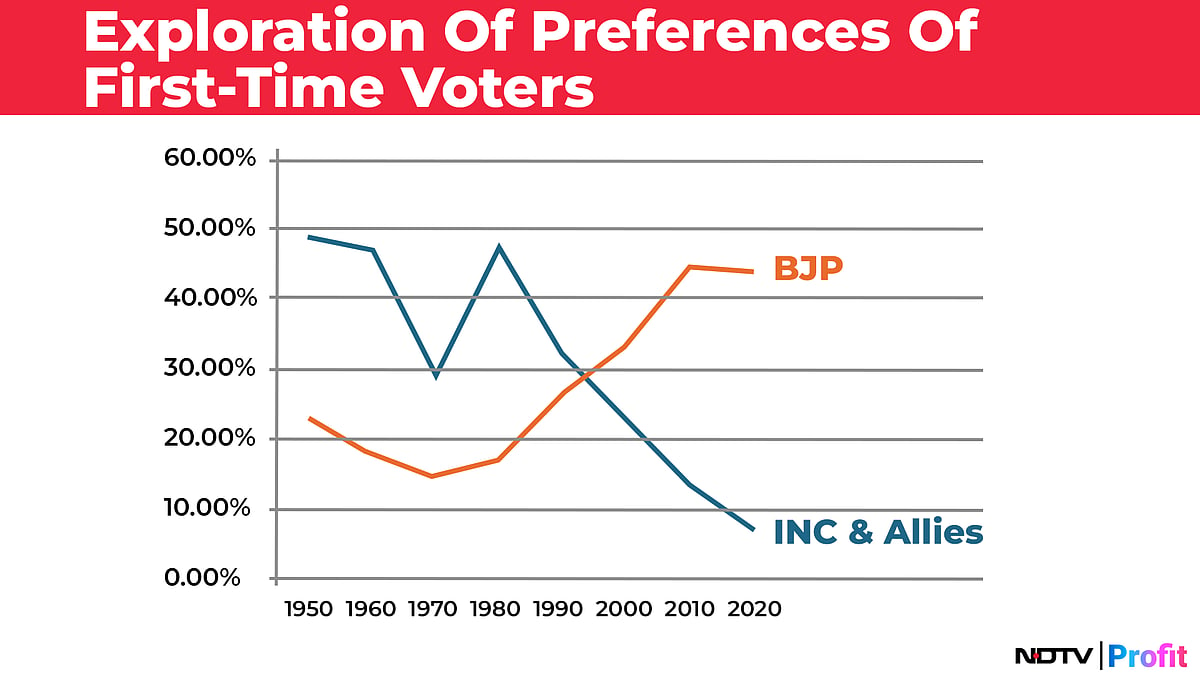
Shankkar Aiyar, political-economy analyst, is the author of 'Accidental India - A History of the Nation’s Passage through Crisis and Change', 'Aadhaar: A Biometric History of India's 12-Digit Revolution' and 'The Gated Republic: India’s Public Policy Failures and Private Solutions.' He posts on X @ShankkarAiyar
Disclaimer: The views expressed here are those of the author and do not necessarily represent the views of NDTV Profit or its editorial team.

